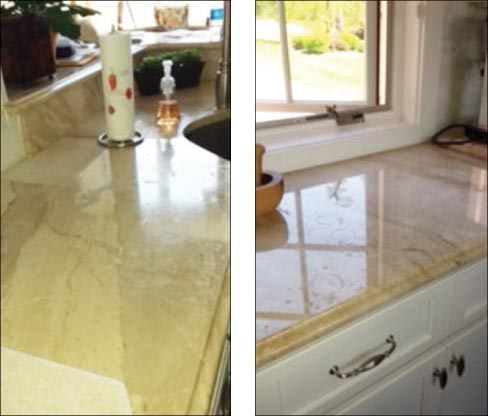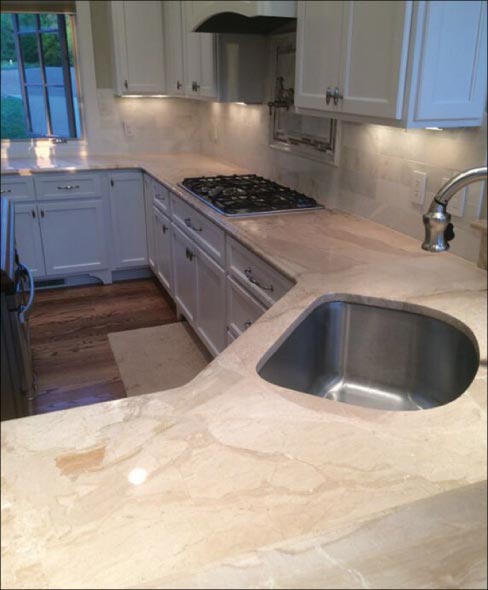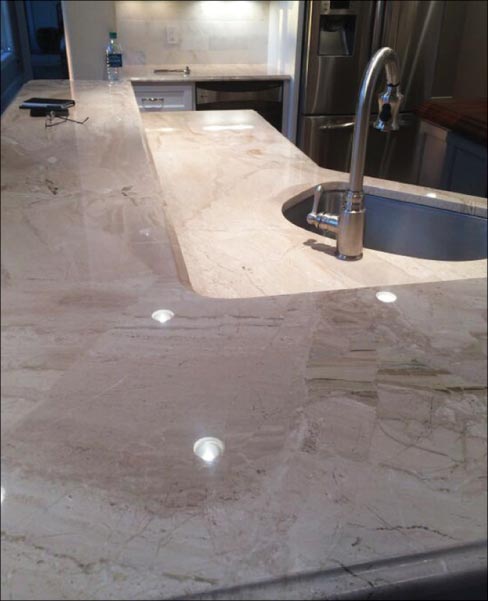Stone Restoration and Maintenance Corner: Using Hand Tools on Raised and Vertical Surfaces
Bob Murrell
Special Contributor
Photos provided by Bob Murrell
 |
|
This once beautiful marble fraternity house shower was a challenge to restore. The photo shows years of calcium and mineral deposits, and the staining of soap scum. |
 |
|
Two examples of marble etching on countertops: Left: white tracks and dull areas around the sink cut-out show etching; and right: the multiple rings on the countertop are a commonly seen problem, left by juice or wine glasses or other acidic liquids. |
 |
|
Honed and polished, the sink area of the counter has been restored to its former beauty. After restoring, I recommend applying a quality sealer. Many homeowners will appreciate a little free education in how to better care for their stone investment. |
 |
|
The upper counter surface was in equally bad shape. After honing, polishing and sealing it looks better than it did when newly installed. |
With marble, French limestone, and other calcium-based stones becoming very popular for countertops, vanities, and vertical surfaces, the demand for restoring these sensitive stones is also increasing.
As we have covered many times in previous articles, calcium–based materials are very chemically sensitive. Of course because they are also much softer on the Mohs Hardness scale, they scratch more easily as well. Therefore by choosing one of these materials for a kitchen countertop or any other preparation surface, bathroom vanity, or shower, it becomes inevitable that restoration will become necessary. In fact, periodic surface restoration will necessarily be routine if the surface is to be maintained.
Polished and higher honed surfaces will require the highest maintenance. This is because they will show etching and scratching the most. Low honed surfaces show fewer chemical and mechanical attacks. Of course the reason that polished and high honed surfaces are chosen is because they better reveal the colors of the stone. Also, shiny is what many customers expect when they think of marble.
Customers choose marble and limestone because it is very ornate or “chic”. Fabricators sell it because they sell what the customers want. Many times customers become baffled or even angry by the quick deterioration of the surface due to the first tomato that is cut or glass of orange juice that is spilled. Virtually every food and drink we consume has a pH value in the acidic range, along with products used in the bathroom as well. That, in combination with cutting, produces etches and scratches on the delicate surface. Showers tend to collect mineral deposits and soap scum around faucets.
That is where the restoration professional comes in to diagnose, fix, and prescribe the proper care and maintenance for the problem. Repairing the surface can be the easy part. Educating the customer to help them avoid or certainly delay the same problems from reoccurring as quickly is the hard part.
The customer should be taught that spilled beverages need to be wiped up as soon as possible and the use of a good cutting board should be implemented. Showers should have a squeegee mounted in a handy location and it should be used routinely to help avoid buildup of conditioner and soap scum.
Use of a premium oleophobic (resists and repels oils) impregnating sealer is highly advised, especially on honed surfaces. This will retard the penetration of all foreign liquid contaminants. Grease, oil, and even acidic spills will be repelled. Impregnators will not stop acid etching but can keep them close to the surface for easier repairs later.
One easy test: the stone should be re-impregnated when the surface no longer causes water to bead satisfactorily. I personally like the newer, low odor solvent-based impregnators as they are easy to work with and the smell doesn’t offend the customers.
Maintenance should be conducted with a No-Rinse Neutral Cleaner, Stone Soap, Stone Plus, or Conditioning Treatment and Polish. Of course it depends on whether the finish is honed or polished.
Now for the actual restoration procedures. If the surface is honed, use of a 200 grit to 400 grit diamond should be sufficient. If polishing, you would normally go to at least an 800 grit or maybe even an 1800g before polishing with either a 5X stone polishing compound, or one of the newer powders like 10X. It all depends on the stone and the results of your preliminary testing.
Diamond impregnated pads can be used if the etching and scratching are not too bad. They are easier to use and less messy than diamond discs. However, diamond discs normally give a better reflection when re-polishing a surface.
I can say confidently that it would be a very rare occasion that a diamond abrasive coarser than a 220 grit would be necessary on a countertop. In most cases with a polished surface, a 400g followed with an 800 grit diamond and finally polished using one of the powders or compounds should be sufficient. Using abrasives coarser than 220 grit make taking the slab off plane or dipping more likely. When it comes to slab surface work, monolithic (flat) is the name of the game. Wavy surfaces look bad and because they are closer to our eyes, they are more noticeable.
Typically I will say that larger diameter pads make for less wave possibility on slab surfaces. Therefore, a 5˝ diameter disc is better than a 4˝ inch, and a 7˝ diameter disc is better than a 5˝. However, the larger diameter discs also don’t get into tight situations well. It is not necessary to get to the edges in many cases and feathering should be implemented. In other words, use the starting grit disc on the bad areas, then use the next successive grit feathering out to a larger area.
Finally, polish the whole thing to the edge to blend. Note: always routinely use some anti-seize on the spindle of your handle tool to ensure driver pads and accessory tools easily screw on and off.
On honed surfaces, diamond impregnated pads come in very handy for eliminating honing marks (swirls caused by resins). For example, if you hone with a 220 grit and then a 400 grit diamond disc, I would recommend finishing up using a 400g diamond impregnated pad to smooth out and make everything consistent. It works most every time.
There are also some new accessory tools on the market. I have been using a specialty weighted driver designed to fit on standard restoration tools (right angle slow speed with variable drive and a 5/8-11 spindle). It keeps the disc flat and makes honing easy, even for technicians with not much experience. It works for most everything when using diamonds both wet and dry. It contains the slurry and also has a dry vacuum attachment for dry grinding of concrete and other materials. Stay tuned for more on this very handy tool.
Of course there are many variables to consider when doing elevated horizontal and vertical surfaces. We all know about green marble (serpentine). So be prepared, do a test (or two), and take everything with you that you can possibly think of. Razor blades are useful in removing heavy soap scum build up in showers and then cleaned with heavy duty soap scum removers before honing or polishing.
I will discuss how to price projects in a future article, but suffice to say that these types of restoration projects are priced by the job – and not necessarily by the square foot, like floor projects. I would not even show up for less than a certain predetermined amount. You can’t afford to.
As always, I have to close with the importance of partnering with a good distributor of quality products and technical support. It is essential for a contractor’s success.